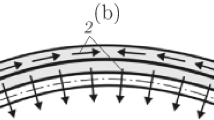Abstract
A new method of the analysis of a plate composed of thin layers of isotropic linear elastic material is developed. A general solution for displacement, resultant stress and resultant moment fields is obtained by using the complex function theory. It is proved that the complete solutions of the laminated plate subjected to tractions prescribed on its boundary can be obtained from the sum of solutions for uncoupled plates. Particular attention is devoted to the crack tip field and energy release rate for the laminated plate. A closed form solution for singular fields near the crack tip and the relation between the J-integral and the intensity factors are derived through the complex potential formula. Complete forms of the complex potentials for a crack in an infinite laminate as well as for the singularities such as a point force, a point moment and a dislocation are also obtained.
Similar content being viewed by others
References
Becker, W. (1991). A complex potential method for plate problems with bending extension coupling. Archive of Applied Mechanics 61, 318–326.
Becker, W. (1992). Closed–form analytical solutions for a Griffith crack in a non–symmetric laminate plate. Composite Structures 21, 49–55.
Beom, H.G. and Earmme, Y.Y. (1997). The elastic field of an elliptic cylindrical inclusion in a laminate with multiple isotropic layers. Journal of Applied Mechanics, Accepted for Publication.
Eshelby, J.D., Read, W.T. and Shockley, W. (1953). Anisotropic elasticity with applications to dislocation theory. Acta Metallurgica 1, 251–259.
Hui, C.Y. and Zehnder, A.T. (1993). A theory for the fracture of thin plates subjected to bending and twisting moments. International Journal of Fracture 61, 211–229.
Irwin, G.R. (1957). Analysis of stresses and strains near the end of a crack traversing a plate. Journal of Applied Mechanics 24, 361–364.
Jones, R.M. (1975). Mechanics of Composite Materials. Scripta, Washington.
Lekhnitskii, S.G. (1963). Theory of Elasticity of an Anisotropic Elastic Body.Holden–Day, San Francisco.
Lu, P. and Mahrenholtz, O. (1994). Extension of the Stroh formalism to the analysis of bending of anisotropic elastic plates. Journal of the Mechanics and Physics of Solids 42, 1725–1741.
Murakami, Y. (1987). Stress Intensity Factors Handbook. Pergamon, Oxford.
Muskhelishvili, N.I. (1954). Some Basic Problems of the Mathematical Theory of Elasticity.Noordhoff International Publishing, Leyden.
Reismann, H. and Pawlik, P.S. (1980). Elasticity: Theory and Applications. John Wiley & Sons, New York.
Rice, J.R. (1968). A path–independent integral and the approximate analysis of strain concentration by notches and cracks. Journal of Applied Mechanics 35, 379–386.
Sanders, J.L., Jr. (1960). On the Griffith–Irwin fracture theory. Journal of Applied Mechanics 27, 352–353.
Savin, G.N. (1961). Stress Concentration Around Holes.Pergamon Press, London.
Stroh, A.N. (1958). Dislocations and cracks in anisotropic elasticity. Philosophical Magazine 7, 625–646.
Suo, Z. (1989). Singularities interacting with interfaces and cracks. International Journal of Solids and Structures 25, 1133–1142.
Timoshenko, S.P. and Woinowsky–Krieger, S. (1959). Theory of Plates and Shells.McGraw–Hill, London.
Williams, M.L. (1961). The bending stress distribution at the base of a stationary crack. Journal of Applied Mechanics 28, 78–82.
Young, W.C. (1989). Roark's Formulas for Stress and Strain.McGraw–Hill, London.
Zakharov, D.D. (1995). Formulation of boundary–value problems of statics for thin elastic asymmetrically–laminated anisotropic plates and solution using functions of a complex variable. Journal of Applied Mathematics and Mechanics 59, 615–623.
Author information
Authors and Affiliations
Rights and permissions
About this article
Cite this article
Beom, H., Earmme, Y. Complex variable method for problems of a laminate composed of multiple isotropic layers. International Journal of Fracture 92, 305–324 (1998). https://doi.org/10.1023/A:1007570226527
Issue Date:
DOI: https://doi.org/10.1023/A:1007570226527



